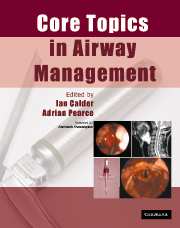Book contents
- Frontmatter
- Contents
- List of contributors
- Preface
- Acknowledgements
- List of abbreviations
- 1 Anatomy
- 2 Physiology of apnoea and hypoxia
- 3 Physics and physiology
- 4 Cleaning and disinfection of airway equipment
- 5 General principles
- 6 Maintenance of the airway during anaesthesia: supra-glottic devices
- 7 Tracheal tubes
- 8 Tracheal intubation of the adult patient
- 9 Confirmation of tracheal intubation
- 10 Extubation
- 11 Light-guided intubation: the trachlight
- 12 Fibreoptic intubation
- 13 Retrograde intubation
- 14 Endobronchial and double-lumen tubes, bronchial blockers
- 15 ‘Difficult airways’: causation and prediction
- 16 The paediatric airway
- 17 Obstructive sleep apnoea and anaesthesia
- 18 The airway in cervical trauma
- 19 The airway in cervical spine disease and surgery
- 20 The aspiration problem
- 21 The lost airway
- 22 Trauma to the airway
- 23 Airway mortality associated with anaesthesia and medico-legal aspects
- 24 ENT and maxillofacial surgery
- 25 Airway management in the ICU
- 26 The airway in obstetrics
- Index
17 - Obstructive sleep apnoea and anaesthesia
Published online by Cambridge University Press: 15 December 2009
- Frontmatter
- Contents
- List of contributors
- Preface
- Acknowledgements
- List of abbreviations
- 1 Anatomy
- 2 Physiology of apnoea and hypoxia
- 3 Physics and physiology
- 4 Cleaning and disinfection of airway equipment
- 5 General principles
- 6 Maintenance of the airway during anaesthesia: supra-glottic devices
- 7 Tracheal tubes
- 8 Tracheal intubation of the adult patient
- 9 Confirmation of tracheal intubation
- 10 Extubation
- 11 Light-guided intubation: the trachlight
- 12 Fibreoptic intubation
- 13 Retrograde intubation
- 14 Endobronchial and double-lumen tubes, bronchial blockers
- 15 ‘Difficult airways’: causation and prediction
- 16 The paediatric airway
- 17 Obstructive sleep apnoea and anaesthesia
- 18 The airway in cervical trauma
- 19 The airway in cervical spine disease and surgery
- 20 The aspiration problem
- 21 The lost airway
- 22 Trauma to the airway
- 23 Airway mortality associated with anaesthesia and medico-legal aspects
- 24 ENT and maxillofacial surgery
- 25 Airway management in the ICU
- 26 The airway in obstetrics
- Index
Summary
Worldwide, obstructive sleep apnoea (OSA) is the most common medical disorder affecting sleep, afflicting about 5% of the middle aged in the UK and about 80% of those affected are male. The full range of sleep disorders has been classified by the American Sleep Disorders Association (Table 17.1). The high prevalence of OSA means that anaesthetists are frequently involved with such patients presenting either for surgery as part of treatment for the condition itself or for unrelated surgery. This chapter deals with the pathophysiology of the condition and its presenting features, investigations and treatment. It concludes with management during the peri-operative period. Sleep apnoea in children is also considered briefly.
Definition and presentation of OSA
OSA is defined as a repetitive obstruction of the upper airway during sleep causing hypoxaemia with arterial oxygen desaturation, which leads to a reduced quality of sleep. When this results in excessive daytime sleepiness (EDS), the condition is often referred to as sleep apnoea syndrome. There is almost always a history of snoring that has worsened over the preceding few years, often causing patients to sleep separately from their partners. The obstruction to the airway may arise from a number of discrete anatomical causes that are listed in Table 17.2, but in the absence of abnormal anatomy, it is relaxation of the pharyngeal constrictor muscles during sleep that allows collapse of the airway. There is evidence that these muscles are hypertonic during wakefulness, and that fatigue may become unmasked during sleep leading to excessive relaxation. Physical associations with OSA include being male, a collar size of 17 in. or greater, a large tongue and often some degree of retrognathia.
- Type
- Chapter
- Information
- Core Topics in Airway Management , pp. 131 - 138Publisher: Cambridge University PressPrint publication year: 2005



